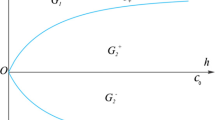Abstract
In (J. Comput. Phys. 229: 8105–8129, 2010), Li and Qiu investigated the hybrid weighted essentially non-oscillatory (WENO) schemes with different indicators for Euler equations of gas dynamics. In this continuation paper, we extend the method to solve the one- and two-dimensional shallow water equations with source term due to the non-flat bottom topography, with a goal of obtaining the same advantages of the schemes for the Euler equations, such as the saving computational cost, essentially non-oscillatory property for general solution with discontinuities, and the sharp shock transition. Extensive simulations in one- and two-dimensions are provided to illustrate the behavior of this procedure.
Similar content being viewed by others
References
Alcrudo, F., Benkhaldoun, F.: Exact solution to the Riemann problem of the shallow water euqaionts with a bottom step. Comput. Fluids 30, 643–671 (2001)
Bermudez, A., Vazquez, M.E.: Upwind methods for hyperbolic conservation laws with source terms. Comput. Fluids 23, 1049–1071 (1994)
Cockburn, B., Shu, C.-W.: TVB Runge-Kutta local projection discontinuous Galerkin finite element method for conservation laws II: General framework. Math. Comput. 52, 411–435 (1989)
Cosat, B., Don, W.S.: High order hybrid central-WENO finite difference scheme for conservation laws. J. Comput. Appl. Math. 204, 209–218 (2007)
Crnjaric, N., Vukovic, S., Sopta, L.: Extension of ENO and WENO schemes to one-dimensional sediment transport equations. Comput. Fluids 33, 31–56 (2004)
Fennema, R.J., Chaudhry, M.H.: Explicit methods for 2D transient free surface flows. J. Hydraul. Eng. 116, 1013–1034 (1990)
Harten, A.: Adaptive multiresolution schemes for shock computations. J. Comput. Phys. 115, 319–338 (1994)
Jiang, G., Shu, C.-W.: Efficient implementation of weighted ENO schemes. J. Comput. Phys. 126, 202–228 (1996)
Krivodonova, L., Xin, J., Remacle, J.-F., Chevaugeon, N., Flaherty, J.: Shock detection and limiting with discontinuous Galerkin methods for hyperbolic conservation laws. Appl. Numer. Math. 48, 323–338 (2004)
LeVeque, R.J.: Balancing source terms and flux gradient on high-resolution Godunov methods: the quasi-steady wave-propagation algorithm. J. Comput. Phys. 146, 346–365 (1998)
Li, G., Qiu, J.: Hybrid weighted essentially non-oscillatory schemes with different indicators. J. Comput. Phys. 229, 8105–8129 (2010)
Pirozzoli, S.: Conservative hybrid compact-WENO schemes for shock-turbulence interaction. J. Comput. Phys. 178, 81–117 (2002)
Qiu, J., Shu, C.-W.: A comparison of troubled-cell indicators for Runge-Kutta discontinuous Galerkin methods using weighted essentially nonoscillatory limiters. SIAM J. Sci. Comput. 27, 995–1013 (2005)
Rogers, B.D., Borthwick, A.G.L., Taylor, P.H.: Mathematical balancing of flux gradient and source terms prior to using Roe’s approximate Riemann solver. J. Comput. Phys. 192, 422–451 (2003)
Shu, C.-W., Osher, S.: Efficient implementiation of essentially non-oscillatory shock-capturing schemes. J. Comput. Phys. 77, 439–471 (1988)
Shu, C.-W.: Essentially non-oscillatory and weighted essentially non-oscillatory schemes for hyperbolic conservation laws. NASA/CR-97-206253, ICASE Report NO.97-65 (1997)
Shu, C.-W.: High order weighted essentially nonoscillatory schemes for convection dominated problems. SIAM Rev. 51, 82–126 (2009)
Toro, E.F.: Shock-capturing Methods for Free-surface Shallow Flows. Wiley, New York (2001)
Vukovic, S., Sopta, L.: ENO and WENO schemes with the exact conservation property for one-dimensional shallow water equations. J. Comput. Phys. 179, 593–621 (2002)
Xing, Y., Shu, C.-W.: High order finite difference WENO schemes with the exact conservation property for the shallow water equations. J. Comput. Phys. 208, 206–227 (2005)
Xing, Y., Shu, C.-W.: High-order well-balanced finite difference WENO schemes for a class of hyperbolic systems with source terms. J. Sci. Comput. 27, 477–494 (2006)
Xing, Y., Shu, C.-W.: High order well-balanced finite volume WENO schemes and discontinuous Galerkin methods for a class of hyperbolic systems with source terms. J. Comput. Phys. 214, 567–598 (2006)
Xing, Y., Zhang, X., Shu, C.-W.: Positivity-preserving high order well-balanced discontinuous Galerkin methods for the shallow water equations. Adv. Water Resour. 33, 1476–1493 (2010)
Zhou, J.G., Causon, D.M., Mingham, C.G., Ingram, D.M.: The surface gradient method for the treatment of source terms in the shallow-water equations. J. Comput. Phys. 168, 1–25 (2001)
Zhu, H., Qiu, J.: Adaptive Runge-Kutta discontinuous Galerkin methods using different indicators: one-dimensional case. J. Comput. Phys. 228, 6957–6976 (2009)
Author information
Authors and Affiliations
Corresponding author
Additional information
The research was partially supported by NSFC 10931004, 40906048 and Science research fund of Nanjing University of Information Science & Technology 20090203.
Rights and permissions
About this article
Cite this article
Li, G., Lu, C. & Qiu, J. Hybrid Well-balanced WENO Schemes with Different Indicators for Shallow Water Equations. J Sci Comput 51, 527–559 (2012). https://doi.org/10.1007/s10915-011-9520-4
Received:
Revised:
Accepted:
Published:
Issue Date:
DOI: https://doi.org/10.1007/s10915-011-9520-4




